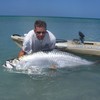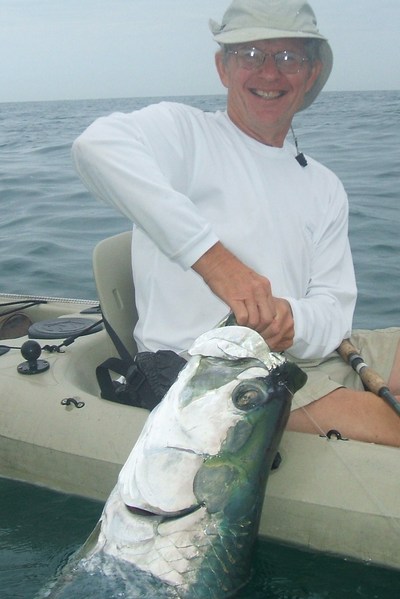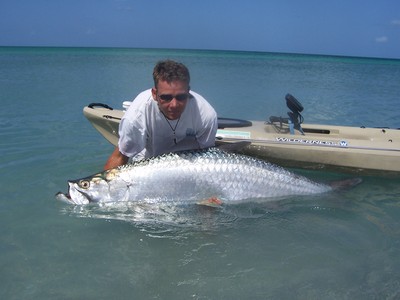Kayak fishing over the past couple of years has become one of the fastest growing areas of sport fishing in North America. In Florida, as in many other coastal and freshwater areas across the country, anglers are leaving behind their expensive and environmentally destructive power boats for kayaks that are cheaper, stealthier, and friendlier to the environment. Anglers of all skill levels are amazed at the versatility and maneuverability these vessels have for navigating the skinny waters of the extensive grass flats and backcountry that Florida's waterways have to offer. But what many fail to realize is that the kayak is equally as effective of an offshore fishing tool as it is for inshore fishing. With just a few minor adjustments to your fishing technique you can be catching king mackerel, cobia, shark and grouper along with inshore favorites like snook, redfish and sea trout, and in greater numbers than your motorized counterparts. Tarpon fishing is no exception. In fact fishing for tarpon from a kayak is one the most rewarding and exhilarating experiences an angler can possibly have.
Tarpon are known for their long line -peeling runs, rod bending pulls, and surface-breaking acrobatic displays, all of which is magnified by taking the fight right to the fish. It's man verses nature in all its primal glory, with victory going to the one who wants it the most. Needless to say it takes a lot of preparation and some change in tactics if you are going to tackle an adversary such as a tarpon from your kayak. The following are some tips and tactics that I use at SUN COAST KAYAK SPORT FISHING (www.suncoastkayaksportfishing.com) to give both myself and my clients an edge when it comes to hooking up and landing trophy tarpon.
EQUIPMENT
To fish from a kayak for tarpon you must first have the right gear. Start with your kayak. For shallow water fishing a smaller more maneuverable kayak is the obvious choice. When taking to the open water though you are going to want a longer kayak for two reasons, The first is that they track better and are geared for paddling long distances. The larger size also makes it easier to cut through any chop or surf that you may encounter. The second reason is that when battling a large game fish you want to increase your drag on the water's surface. By this I mean that while fighting a large fish they have a tendency to pull a kayak around, by angling your kayak so that the fish is pulling you sideways you increase the drag on the surface of the water and help slow the fish down.
Rod and reel selection is also very important. I believe that a large spinning outfit is best suited for tarpon. You want to pick a reel that is sturdy and well built to take the prolonged punishment of a long fight. Equally as important is that it should hold a minimum of 250 yards of at least 20# monofilament. When picking a rod it should once again be sturdy and well built, preferably a medium-heavy action with a little give at the tip. Most importantly don't buy a cheap rod and reel just to save a few dollars. Trust me, when the time comes and you finally get that hook up with a trophy fish you'll be glad for every dollar spent. Finish off your outfit by tipping the monofilament with 50#-80# fluorocarbon leader of about 5' to 6' in length depending on the length of your rod. At the terminal end attach a sturdy 9/0 circle hook with a very sharp point. The sharper the point the better. Tarpon's mouths are very tough and a strong sharp hook is needed to penetrate for a secure hook set. Once again I can't emphasize enough that you should not skimp on quality for the sake of a few dollars. I know that hooks seem like an incidental thing but weak and dull hooks lead to less hook ups, less secure hook sets, and ultimately more lost fish. The circle hook is absolutely key to Tarpon Fishing. The circle hook not only results in near perfect hook sets on the upper jaw almost 90% of the time but drastically reduces the chances of gut or foul hooking these magnificent game fish - reducing the mortality rates of released fish.
BAIT
Bait selection is equally as important as gear selection. Choosing live bait and keeping it healthy and lively is definitely a key factor in catching more fish. For keeping live bait for long periods of time it is beneficial to outfit your kayak with an aerator and some kind of livewell. Your livewell can be anything from an old 5-gallon bucket to a small cooler as long as a small aerator is attached to provide ample oxygen flow, and should hold at least 3 gallons of water to keep a good supply of bait on hand. There are tons of commercially produced options for keeping your bait alive.
My baits of choice for tarpon are either crabs or threadfin herring. Pick crabs that are energetic and range in size from 2" to 3". I usually carry up to a half dozen per person on each trip. Threadfin are readily available as you make your way along the beaches in the early morning. It is very beneficial to carry a small lightweight rod with a sabiki rig to gather them as you get started. Check the bridges, jetties or other structure as a good source of large threadfin. Once a school is found cast the sabiki into the school and reel it back jerking the rod as you go. Keep only a few at a time so that the livewell doesn't become overcrowded and oxygen depleted, there is always another chance for more bait later on should you need it.
CATCHING TARPON ON A KAYAK
Here in Sarasota, on Florida's West Coast, the large schools of tarpon begin to show up around the first of May and remain until roughly the end of June depending on the water conditions. While some fish do remain in the area well past this time, especially in Tampa Bay, the big schools tend to break up and are harder to fish. At this time you find yourself chasing one or two fish instead of a large more visible school. The peak time is around the end of May and the beginning of June, keeping in mind that it is a little earlier to the south and later to the north. It's at this time that the largest concentration of fish tend to be in this area year after year, and that leads to better chances of a hook up.
Begin your quest for tarpon early in the morning, just after the sun begins to rise. It's at this time that all of the conditions from weather to visibility are more in your favor. Tarpon are more active in the morning, and it is easy to spot the schools cruising the beaches in their characteristic rolling motion, breaching the surface much like a dolphin surfacing for air. The key is to find a nice sized school and stay with it as it moves down the beach, being careful to keep your distance as they go. You are essentially waiting for them to lay up, or daisy chain, which is to stop moving and hold up in a single area.
Once the school lays up is when the difficult part begins. Taking into account the way you will drift set yourself up in front of the school about 20 yards away. This allows some room for the school to move and some error on your part if your drift is wrong. Motorized boats employ trolling motors at this point to keep a safe distance away but you will have to simply judge for wind direction and make corrections in light strokes of your paddle. The last thing you want to do is spook the school by floating into it or getting to close and causing them to move again.
Bait presentation is everything at this point. What you want to do is drop your bait about 10 feet from the lead fish, allowing time for it to sink a few feet below the surface before it is encountered by a hungry tarpon. The reason being is that when the fish rolls on the surface you want the bait to be below it as it begins to swim down, allowing the fish to simply scoop it up. The last thing you want to do is overcast your bait into the school itself which will either spook them or once you have a hook set you face having it broken off by another fish hitting your line.
If a fish takes your bait allow your line to go tight for a few seconds and then begin reeling as fast as you can while holding your rod low and jerking it hard a couple of time in the opposite direction the fish is going. This is going to help insure a good hook set by driving the hook into the tarpon's thick mouth. Now hold on because this fish is going to take off and you are going for a ride. At first the fish is most likely going to peel off a lot of your line, but try not to panic because that's why you have a reel with at least 250 yards of line on it. Keep your drag at about 1/3 it's tensile strength until after the fish settles down .At this point you need to be very attentive to your line. At some point after the initial hook set and run the fish is going to head for the surface and jump in an attempt to throw the hook. When you see your line straightening out, and the fish is about to break the surface, it is critical that you thrust your rod tip at the fish and give it some extra slack to prevent a break off. This is called bowing to the king. Once the fish is back in the water immediately put the pressure back on it and get as much line back as possible. Some fish jump once throughout the fight and others jump multiple times, so be ready and attentive to your line.
From this point on it is simply a matter of keeping the pressure on the fish to tire him out and get him to boat side. The best way to do this is to keep your line tight and going in the opposite direction of the fish, as if you were trying to pull it back at you. This is going to make it impossible for the fish to rest and catch a second wind, because if it does you are back to square one. This is when you also want to angle your kayak sideways to increase your surface drag. It is right here that the kayak angler has the greatest advantage over a large powerboat. On a motorboat the fish is merely fighting against the drag on your reel and your leverage on the rod. But on a kayak you have added a whole new dimension, the fish is now fighting the drag on your reel, the leverage you put on your rod, and the added weight of pulling you and all your gear against the surface of the water. You can also employ the use of a drift chute, or sea anchor, to help put extra pressure on a large fish. Keep in mind also that you are still in store for a couple more jumps and constant turns by the tarpon so be mindful of your line and keep the tension on at all times and bow as it breaks the surface.
HANDLING A TARPON AT BOATSIDE
Don't be fooled as you get your tarpon to the side of your kayak, that it is in any way ready to be handled. It is most likely going to take a couple times to boat side before it will be worn down enough to handle. Also be mindful that the fish is going to make erratic last-ditch efforts to escape as you bring it along side each time. Be ready for it to thrash around and remember to keep your balance.
After the fish is no longer green and is ready to be handled for hook removal and a quick couple of snapshots remember that the fish must be resuscitated before being released. Remember to keep the fish in the water at all times to maximize its chances for survival after release. Under Florida laws recently imposed it is illegal to remove a tarpon from the water without proper tags available from the local Tax Collectors office, and while it is legal with the proper tags I encourage everyone to release these magnificent fish unharmed and keep them in the water. Like any other fish hold it at boat side and move it back and forth in the water until it can move away on its own.
Most of all practice catch and release. Even though you are allowed to take a tarpon with the appropriate tag, it is much more beneficial to the ecosystem and fish population to simply snap a couple pictures with the fish in the water and let it go.
ETIQUETTE
One of the most important things to keep in mind while on the water fishing for Tarpon is to observe the proper etiquette towards other anglers. Don't crowd other anglers working a school and give them plenty of room when hooked up and fighting a fish. Also, if another angler or boat is working a school use the leap frog technique to set up further up or down the beach to intercept the school after it passes by the original anglers or they manage to break a fish out and the school moves on. Don't encroach on anglers already fishing and be mindful of others.
DANGERS ON THE WATER
Tarpon fishing by kayak is not totally free of potentially hazardous situations. After all you are targeting and fighting large fish often well over 100#. There are many times throughout the fight in which something can go tragically wrong and result in injury or even more important - death. Other dangers include large sharks feeding on struggling Tarpon at or near the boat, and other boaters. I genuinely recommend that everyone try kayak fishing for Tarpon with a guide first before trying it on their own, especially for the less experienced anglers.
Most of all have fun.
Good luck and tight lines to all.




